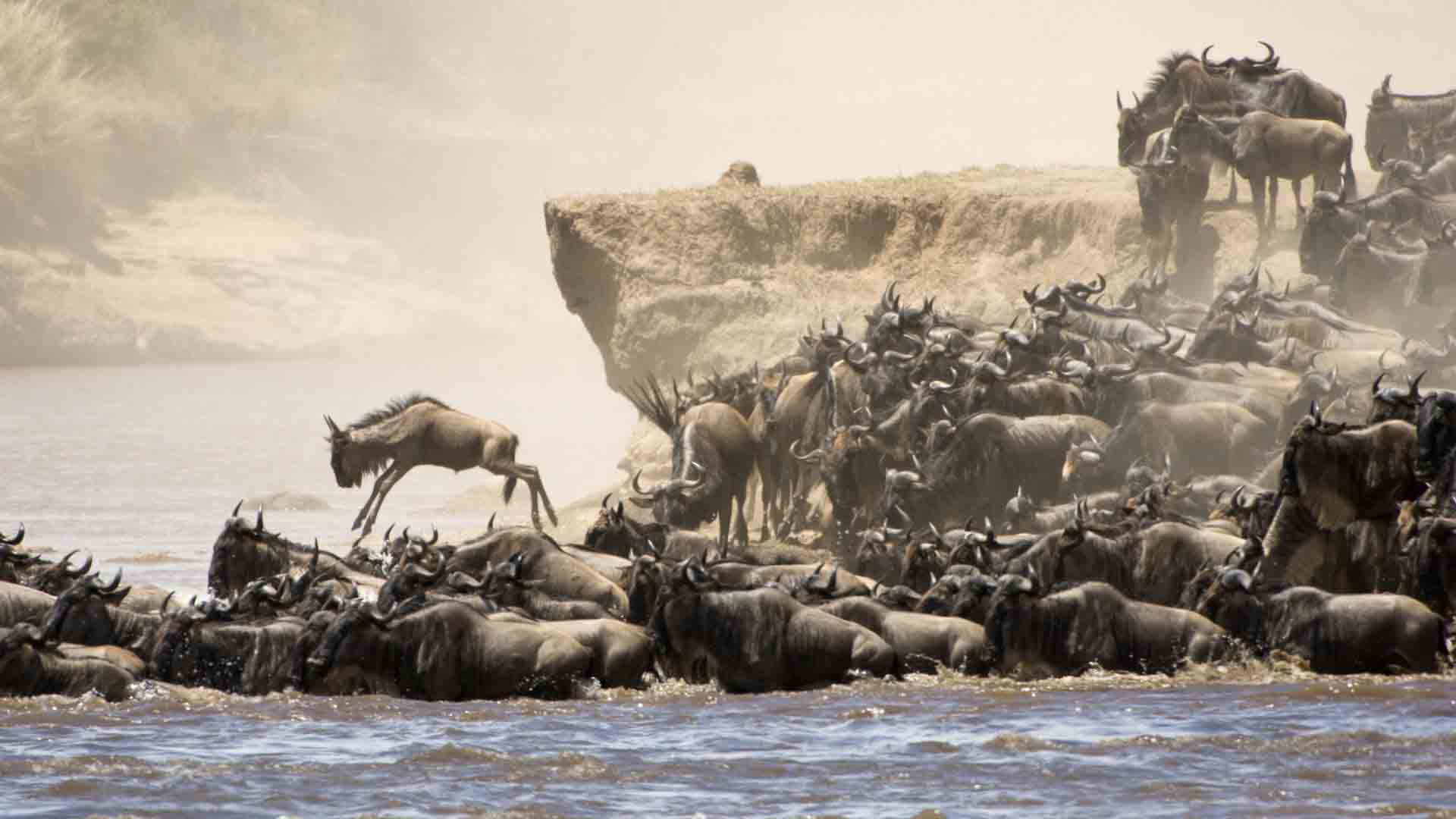Depending on what you hope to see or do, there is no one optimal time to travel to Tanzania. Depending on when you decide to visit, you’ll have a slightly different experience because the country’s seasons and wildlife populations are determined by the rainfall.
The Great Migration, which occurs every year across the Serengeti, is Tanzania’s main draw. Between July and September, a lot of visitors come here to see the enormous herds of zebra and wildebeest that cross the Mara River, trying to avoid the lurking crocodiles and other predators. At this time of year, though, the park will be filled with vehicles.
Between November and March, Tanzania’s “green season,” is significantly more sedate. Although there is a potential of showers, this is a great time to go bird watching because thousands of migrating species are arriving. Herds from the Great Migration and their just born calves are also visible.
The only time you should avoid visiting Tanzania for wildlife viewing is between April and May, when heavy rains can interfere with animal viewing.
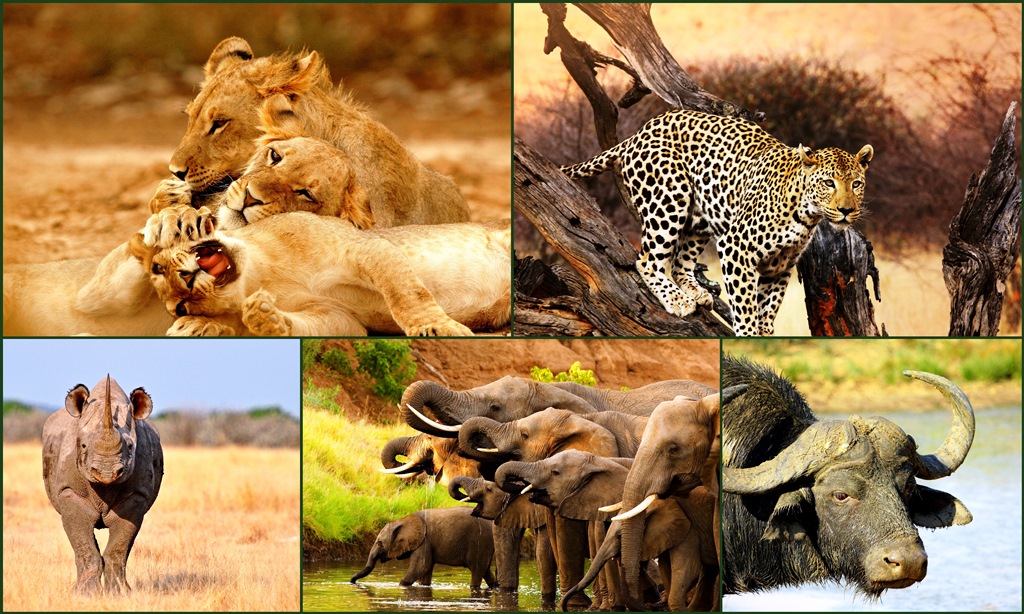 Best time for Big Five Safari
Best time for Big Five Safari
Between June through October, when the weather is slightly cooler but still warm and dry, Tanzania experiences its busiest safari season. There are two key factors that contribute to this time being the best for watching wildlife.
First of all, the foliage is drier and sparser, which essentially makes it simpler to spot animals, particularly the big game like rhinos, elephants, and buffalo. Even the sneakier leopard has a little less foliage to hide in and blend in with.
Second, as smaller ponds and streams dry up, there are fewer water sources accessible. Animals that must drink on a daily basis, like elephants and buffalo, are especially reliant on water. Since the majority of larger mammals need it to survive, they tend to gather around the remaining supplies and are therefore simpler to locate.
However, during certain months, rates are higher and lodging in popular regions fills up more quickly. The remainder of the year, the creatures are still around, but you might have to look a little harder to find them. Choosing the appropriate camp or tour company with knowledgeable, highly skilled professionals as your guides will pay off in spades at this point. They will see animals and hints that can be used to find the Big 5 that you would probably have missed entirely.
Unless you are exceptionally daring or looking for the finest discounts available, it might be wise to skip the months of April and May. Although it rarely rains all day every day, during this time of year, strong rains can make several parks’ roads impassable and force some campgrounds and lodges to close.
Best time for the Great Migration Safari
 Since the Great Migration is a perpetual annual cycle that occurs from place to place, year in and year out, there is no certain time of year to view it. However, your safari can be customized to give you the best opportunity of seeing what you want, depending on either the component of the Great Migration you wish to observe (such as river crossings) or the time of year that you like to travel. These four seasons might be used to summarize the Great Migration.
Since the Great Migration is a perpetual annual cycle that occurs from place to place, year in and year out, there is no certain time of year to view it. However, your safari can be customized to give you the best opportunity of seeing what you want, depending on either the component of the Great Migration you wish to observe (such as river crossings) or the time of year that you like to travel. These four seasons might be used to summarize the Great Migration.
Alternatively, you may find out more about the best time to travel by reading this analysis of the Great Migration by month.
There are a wide range of breathtaking display out in front of you, whether the enormous herds are calving in the south or traveling north in search of richer pastures — and then back again.
Seasons of the Great Migration
The Great Migration can be viewed throughout the year. Although it is possible to anticipate the herds’ locations by analyzing past movement patterns, these animals are wild, and the annual rainfall they depend on to promote grass growth is becoming increasingly unpredictable.
The Calving Season Continues from January to March
 The southern Serengeti’s short-grass plains and the westernmost portions of the Ngorongoro Conservation Area are where the herds gather. During a two- to three-week period in February, an estimated 500 000 calves are born. A staggering number of predators anxious to pounce on the helpless infants are attracted to this mass calving.
The southern Serengeti’s short-grass plains and the westernmost portions of the Ngorongoro Conservation Area are where the herds gather. During a two- to three-week period in February, an estimated 500 000 calves are born. A staggering number of predators anxious to pounce on the helpless infants are attracted to this mass calving.
Dec./January – The wildebeest may graze on the fresh, sweet grasses that are abundant on the Southern Plains. The herds will spend some time enjoying the plentiful grass in the areas around Ndutu and the northern Ngorongoro Conservation Area in order to be ready for the birth of the new calves.
February – Over 80% of pregnant mother wildebeest give birth to their calves within a few weeks of one another between late January and mid-March. The grasslands are dotted with more than 500,000 small wildebeest, and the predators swoop in to feast on the available food.
March – As the plains begin to dry out, the wildebeest are still present in the southern part of the Park at this time but are getting ready to travel north.
The Trek North and the Rut Seasons run from mid-April through mid-June.
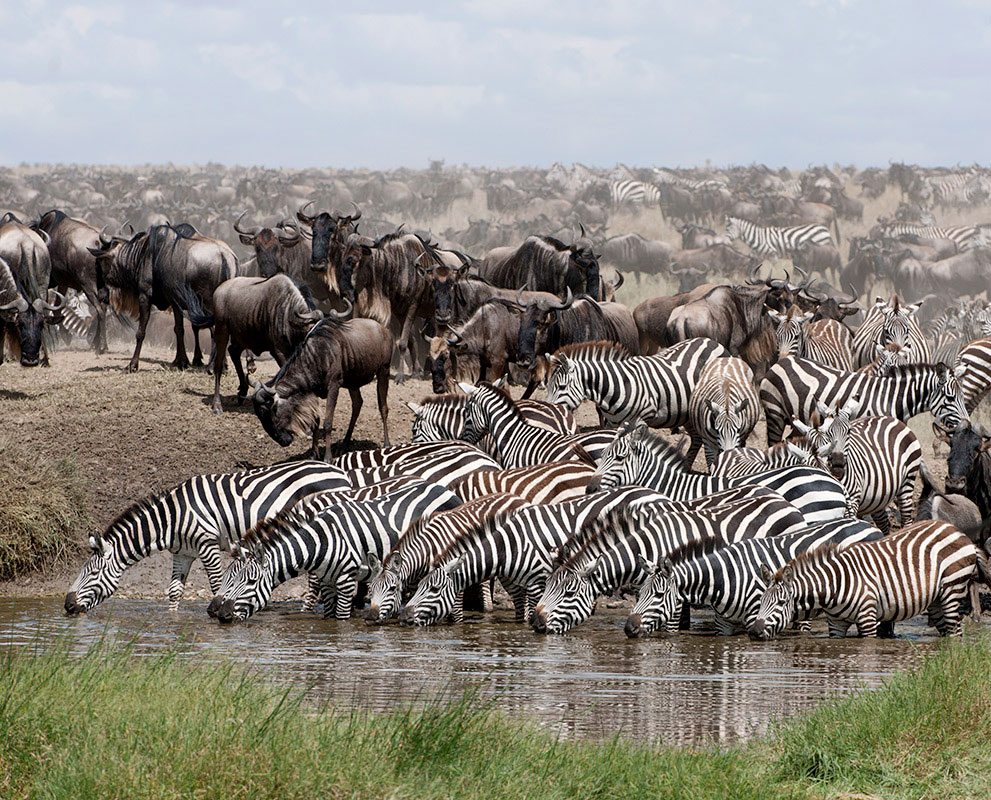 The herds begin migrating northward into the middle Serengeti when the rains cease and the earth dries, where the grass is still young and they can feed and take care of their young. They move slowly and feed along the way, taking advantage of the new grass. The male wildebeest start to fight ferociously for a mate as mating season approaches. During the rut, some herds continue their trek by crossing the Grumeti River and moving toward the west towards the Western Corridor.
The herds begin migrating northward into the middle Serengeti when the rains cease and the earth dries, where the grass is still young and they can feed and take care of their young. They move slowly and feed along the way, taking advantage of the new grass. The male wildebeest start to fight ferociously for a mate as mating season approaches. During the rut, some herds continue their trek by crossing the Grumeti River and moving toward the west towards the Western Corridor.
April: The wildebeest start their arduous journey north through the park’s middle. The herds go around at their own pace, stopping to graze.
May – In the middle of the park, the Moru Kopjes are flooded by spectacular columns of wildebeest that can stretch for several kilometers.
First part of June – In the Western Serengeti, large groups of wildebeest are seen on the southern banks of the Grumeti River, preparing to take on their first obstacle: crossing the crocodile-infested river.
Great Migration River Crossing Season: Mid-June to November
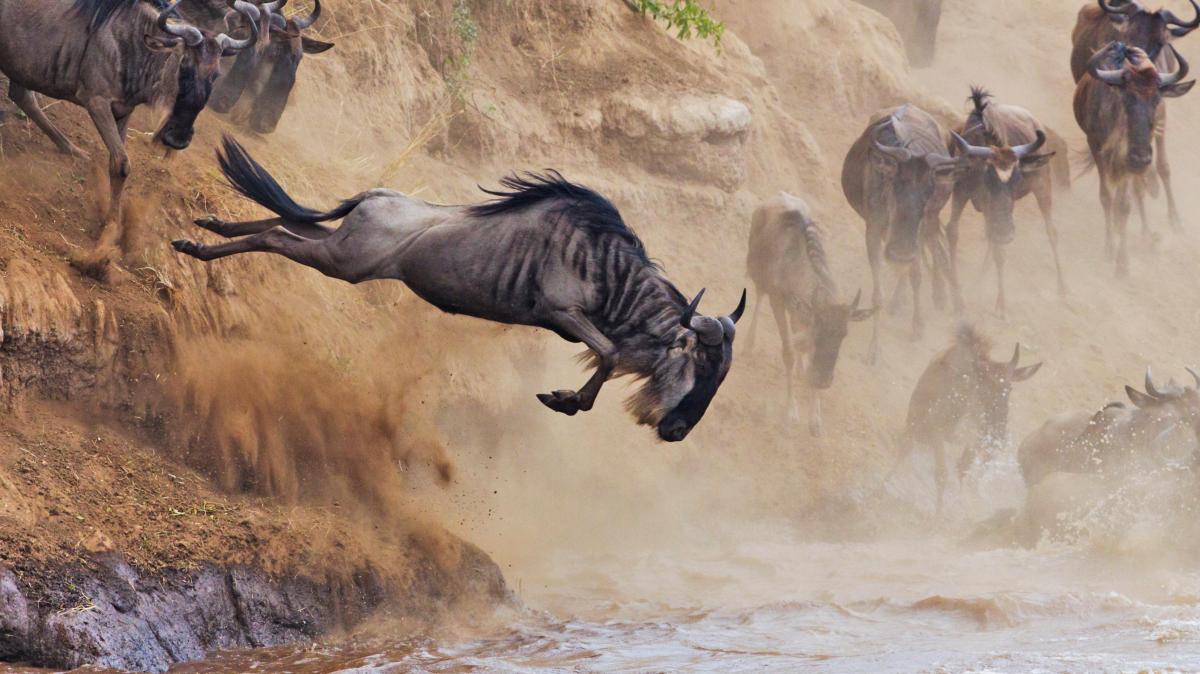 The herds go from the Serengeti’s south to its north. Usually beginning in July, the river crossings—which some people believe to be the Great Migration’s most thrilling activities—depend entirely on the timing of the rains.
The herds go from the Serengeti’s south to its north. Usually beginning in July, the river crossings—which some people believe to be the Great Migration’s most thrilling activities—depend entirely on the timing of the rains.
Both Kenya’s Masai Mara and the Northern Serengeti are home to the herds. The Talek and Mara rivers, which are frequently at the center of intensely dramatic episodes, are where you may watch daily river crossings.
Later, the herds normally return from the Mara and move toward the southern Serengeti, which is now productive. The herds cover great distances quickly and in a single day. When the herds start to calve anew at the beginning of December, the process starts all over again.
July – As the migration picks up speed, enormous herds of wildebeest can be observed traveling north in the Western Corridor. Beginning in early July, the first herds will start to move towards the North.
August – As the dry season approaches, the Great Mara River presents the wildebeest with their second obstacle on their journey. Thousands of calves that were born, far outnumbering the number of deaths.
September: The herds are primarily gathered in Kenya’s Maasai Mara, the trek’s most northern area, but many still stay in the Serengeti.
October: On their second crossing of the Mara River on their way back south, the wildebeest must navigate the rising waters.
November: Short showers start to fall, driving the wildebeest south to the Serengeti’s revitalized grasslands.

MONTH BY MONTH GUIDE
JANUARY
Go on safari in the Ngorongoro Crater in Tanzania in January. Thanks to the advantages of being at a high altitude, you’ll not only be able to avoid the oppressive heat that the rest of the country experiences, but you’ll also find it simple to see the famous Big 5 that roam the crater bottom. If you enjoy watching newborn animals, the Serengeti’s wildebeest calving season occurs in January. Nearly every day, 8,000 wildebeest are born, and you can see them!
You may avoid the crowds and high season pricing on the Southern Tanzania Circuit. Due to the low foot traffic in Nyerere and Ruaha National Parks, you can get great prices at safari lodges. Gome, Mahale, and Kavati are in the midst of their rainy season along the west. The trek to the chimpanzees is challenging, and the continuous downpours make it difficult to see any wildlife.
FEBRUARY
Similar to January, where going on safari in Tanzania will depend on the weather. Due to the ongoing rain, the western parks are still off limits, but the northern and southern Tanzanian circuits are drier. The final few weeks of the wildebeest calving season can be seen if you travel to the southern Serengeti. For bird watchers, Nyerere and Ruaha experience an influx of European migrating birds, while Lake Natron, the birds’ only nesting place in East Africa, welcomes 2.5 million Greater and Lesser flamingos.
MARCH
The lengthy rainy season’s strong rains start in March. Even if the downpours don’t stay all day, they are common and can make some of the roads in the national parks impassable. As a result, lodging establishments in the vicinity of the Southern Tanzania Circuit, including those in Ruaha, Nyerere, and Mikumi, close. But there is still hope! For those who enjoy birds, March is a wonderful month. You can see amazing water birds and hornbill sightings if you go to Lake Manyara.
If March is the only month you can travel to Tanzania for a safari, consult with our team of specialists to learn which parks you can visit without encountering any difficulties.
APRIL
For a Tanzanian safari, April is a month with both advantages and disadvantages. Even though several of the lodges on the Southern and Western circuit are closed due to the excessive rains, you may still get amazing prices. April is one of the least expensive months to travel to Tanzania because almost all of the lodges reduce their rates by 50%.
The most visited parks in the nation are empty of tourists, and despite the rain, the southern Serengeti still offers excellent wildlife watching. Big cats and herbivores may be more difficult to see due to the flouring vegetation.
MAY
Tanzania’s lengthy rains end in May, making it your last chance to take advantage of safari discounts. The greatest time to travel to Tanzania on a tight budget is now when the weather steadily dries up and there are huge savings available. You’ll also have the national parks to yourself because there won’t be many other tourists in the country!
The wildebeest are migrating through the Serengeti. Before turning north, you can see the vast herds migrating across the plains. Due to the wildebeest migration, Serengeti costs are remain expensive even if the rest of the country offers low season rates.
JUNE
The beginning of the dry season brings with it a bounty of sunshine, clear skies, and unrivaled wildlife sightings. Additionally, with the pleasant weather, you may anticipate the start of high season costs and increased foot traffic inside national parks. You can take a safari in the Serengeti to see the wildebeest gather in numbers at the Grumeti River before undertaking the perilous river crossing in their millions. Again accessible along the Western Tanzania Circuit are Katavi and Mahale. For a unique and distant safari experience, including a chimpanzee walk here in your itinerary for the Northern Tanzania Circuit.
JULY
Tanzania’s busy season starts in the month of July. Visit the less crowded national parks in the south and west if you wish to avoid the throng. Even though these areas are less well-known than the north, you’ll still see plenty of animals there! Visit Mahale Mountain National Park or Gombe Stream National Park to undertake chimpanzee trekking. Both have the greatest concentration of wild chimps in Tanzania, and Gombe is the location of Jane Goodall’s world-renowned, longest-running study of chimpanzee behavior. Remember that Tanzania is experiencing its peak travel season wherever you go. Make reservations for your lodging and excursions at least six to eight months in advance.
AUGUST
August is a fantastic time to see wildlife because the irrigation holes are starting to close. The animals go to the few remaining watering holes since there is little vegetation and little rain. Expect to see vast herds of animals and frequent sightings of the Big 5 and elusive big cats.
Want to do more than just go on two daily game drives? Drive to the national parks of Nyerere and Ruaha. You can benefit from the distinctive walking and watercraft safaris as well as the late-night wildlife drives in August. Once more, tourists want to travel to Tanzania in August. Don’t wait until the last minute to make reservations for your travel, lodging, and safari.
SEPTEMBER
The wildebeest make their annual return in September. Millions of the enormous herds go from Kenya to Serengeti National Park, traversing the Masai Mara on their route. Trekking conditions are another reason to go to Tanzania in September. The ascent of Mount Meru and Kilimanjaro is simpler without rain, and you’ll have unobstructed views of Tanzania’s undulating terrain. To get the most for your money, check for safari and hiking combos!
The Ndutu region, which is a part of the Ngorongoro Conservation Area, is in its low season, making it ideal for tourists seeking safaris with fewer crowds and lower prices.
OCTOBER
One of the greatest times to go on a safari along the Western Tanzania Circuit is October. Mahale Mountains National Park is entirely accessible for hiking, and the weather is mild enough to swim in Lake Tanganyika. Additionally, this is the final month before the start of the shorter rainy season in November. Plan a western circuit safari when the weather is dry to make the most of it. At this time of year, Katavi National Park is lovely, and the wildlife is mostly centered around the Katuma River.
Another national park that sparkles in October is Arusha. At dusk and dawn, ascend Mount Meru and keep a look out for hyenas and leopards.
NOVEMBER
In Tanzania, the shorter rainy season begins in November. You may still organize a thrilling safari adventure; you just need to know where to look. Visit national parks like Tarangire National Park and Arusha National Park in the north. The arid landscapes of Nyerere are also a wonderful choice because they endure until December. You may observe the wildebeest moving over the plains even when it does rain in the Serengeti. The predator activity is yet another benefit of traveling to Tanzania in November. There is a chance for an exciting safari because the large cats are searching for young herbivores to devour.
DECEMBER
In December, the brief rainy season begins to end, which boosts tourism in Tanzania. Tanzania receives a flood of visitors for holiday and New Year safari excursions. If you wish to conclude the year here, make your reservations well in advance to guarantee accommodations at the lodges of your choosing and to prepare your budget for the high season rates. December is a month made in paradise for bird lovers. With the arrival of the migratory birds, Nyerere and Tarangire National Park put on a breathtaking wildlife display.
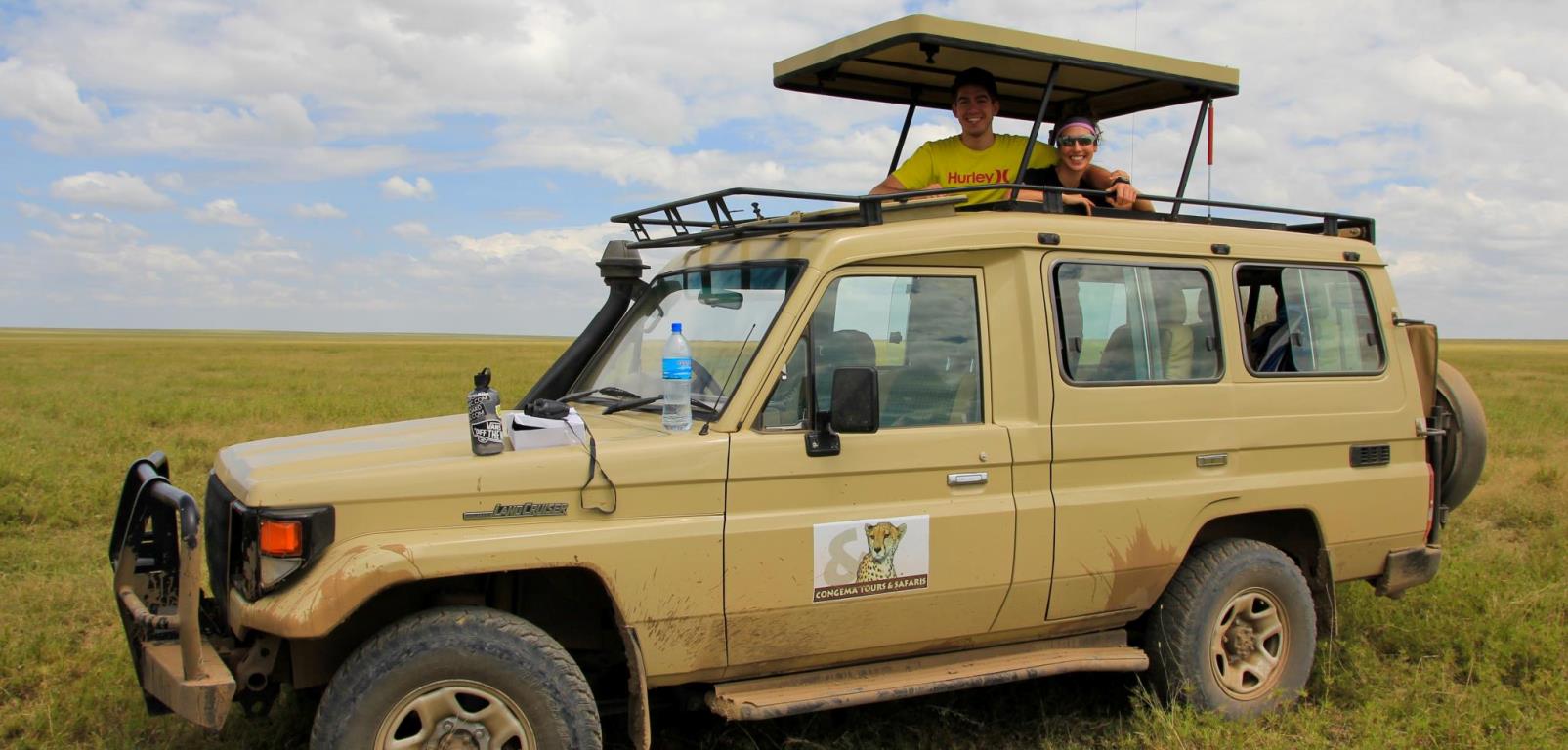 Why visit Tanzania on Low season?
Why visit Tanzania on Low season?
– Least Crowded
– Best time for bird watching
– Green Landscapes, most scenic for photography
– Lowest Rates
-No need to book long on advance
You should be able to choose the ideal time to visit Tanzania based on your itinerary once you know what you’ll be doing there. And if you’re still having trouble, just give us a call; we’d be pleased to help!

